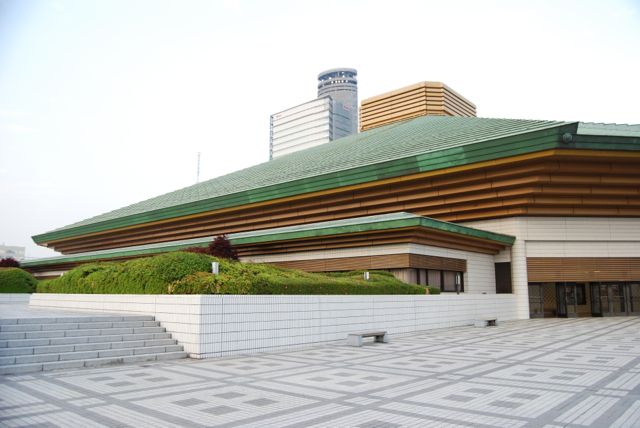Grand Sumo Tournament Posted by sasha on Oct 17, 2012 in Culture, Uncategorized
When you think of Japan, one of the first things that comes to mind is certainly sumo wrestling (相撲). Japan’s national sport has been around for many centuries; it originally began as a performance meant to entertain Shinto gods. Some ancient rituals are still present in modern-day sumo, such as the leg-stomping exercise to drive away evil spirits, and the tossing of salt into the ring to purify it.
Professional sumo wrestlers – known as rikishi (力士 – lit. “strong man”) in Japanese – live a strictly regimented life where they live in a heya (部屋), a training quarters where everything they do is in accordance with tradition. From their hairstyle, to their diet, to their clothing, absolutely every detail of daily life is planned out for them, with strict penalties for breaking rules. When it comes to their diet, wrestlers typically skip breakfast and eat a massive lunch of chakonabe (ちゃんこ鍋), a stew packed full of protein such as chicken or fish, tofu, and vegetables. This strange diet is followed in order for wrestlers to pack on the pounds – there are no weight classes in sumo, so the bigger the better. Every wrestler must belong to a heya, and they are expected to remain with the same one throughout their entire career. Much of their daily life depends on their rank, with senior sekitori (関取) enjoying a more comfortable life than their junior counterparts, who are often forced to do the worst chores and function as personal servants to a designated sekitori.
Step inside the life of a sumo wrestler in this Nat. Geo. video.
While climbing the sumo ladder means a more comfortable life, it also means a much more substantial salary. Lowly wrestlers receive a meager allowance, and the champion earns about $30,000 per month. Bonuses are also dolled out based on performance in major tournaments. In sumo, the champ is known as yokozuna (横綱), which literally means “horizontal rope”; this is because of the distinct rope that is worn around their waist. In order to become a yokozuna, a wrestler must win two major tournaments in a row. Achieving the title is a rare feat indeed – only 70 wrestlers have ever reached this level in the long history of sumo.
There are six Grand Sumo tournaments, called honbasho (本場所) each year: three in Tokyo, and one each in Nagoya, Osaka, and Fukuoka. These last for 15 days, with high level wrestlers fighting a match a day, and lower level guys fighting seven times total. The main goal of every wrestler is to achieve kachi-koshi (勝ち越し), a majority of wins; this usually results in a promotion. The rikishi with the most wins in his division will walk away with the championship, known as yūshō (優勝). For the top division, such a win will earn a wrestler a bonus of around 10 million yen.
While visiting Tokyo, I was fortunate enough to be able to attend a day of the tournament at the Ryōgoku Kokugikan (両国国技館) arena. Outside, we saw plenty of sumo fans waiting near the entrance to snap a picture of their favorite wrestler. Larger than life, the professional sumo wrestlers are quite easy to pick out in a crowd. Lower level matches start early in the morning, and the action continues all day long. Wrestlers are split into East and West divisions, and they use separate locker rooms so as not to see their opponent before the match. In the locker room, wrestlers will don their mawashi (廻し), an elaborate silk apron that is worn during the entrance ceremony. Known as dohyō-iri (土俵入り) in Japanese, this ceremony is performed a few times each day of the tournament, with wrestlers being introduced to the crowd one-by-one in ascending order of their rank.
When it comes to the actual matches, the wrestlers enter the ring from their respective side and perform their pre-match rituals. These often last longer than the match itself, which oftentimes ends in a matter of seconds. Wrestlers crouch at the starting line, stare each other down, and quickly spring for the initial charge. A rikishi wins the bout by either knocking his opponent to the ground or pushing him outside of the ring. A referee, called a gyōji (行司), declares the winner by waving his gunbai (軍配), a war fan. There are also five judges, called shimpan (審判), who sit around the ring and have the right to dispute the ref’s decision. If one judge disagrees with the ref, they all have a small pow-wow in the middle of the ring to come to a group decision. After one particularly intense bout without a clear winner, we saw one of these go down.
With some cold Asahi beers in hand, I thoroughly enjoyed the afternoon of sumo that we saw in Tokyo. Coming at the end of a busy week in Japan, though, the repetitiveness of the matches proved to be too much for my girlfriend, who fell fast asleep in her seat. If you’re planning a trip to Tokyo, you should definitely take the sumo tournament into consideration; it happens three times a year, in January, May, and September. Watching a sumo bout in Japan is like watching Muay Thai in Thailand or WWE in the US – it’s a unique part of the culture that is best enjoyed in person.

Build vocabulary, practice pronunciation, and more with Transparent Language Online. Available anytime, anywhere, on any device.












Comments:
Tim Upham:
It was originally associated with Shinto ritual, where a wrestler took on a kami or a Shinto divine spirit. The wrestling match took place at a Shinto shrine. Which kami would you like to take on?